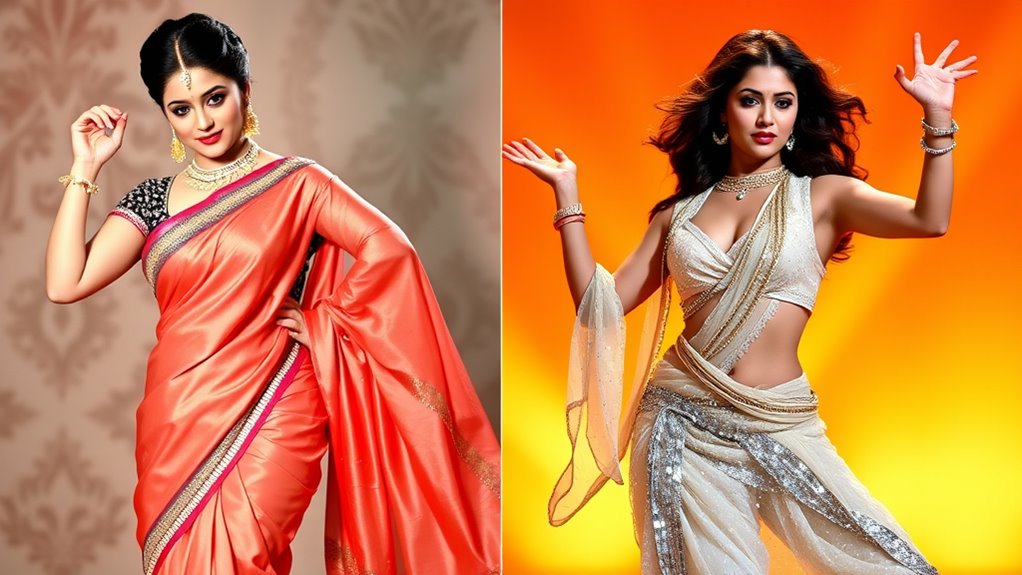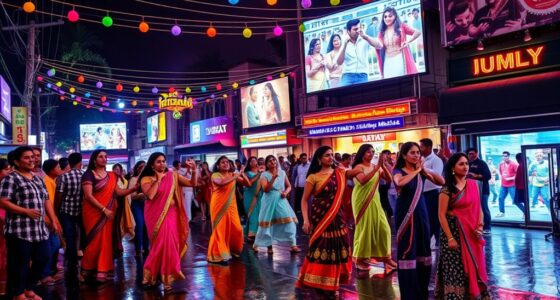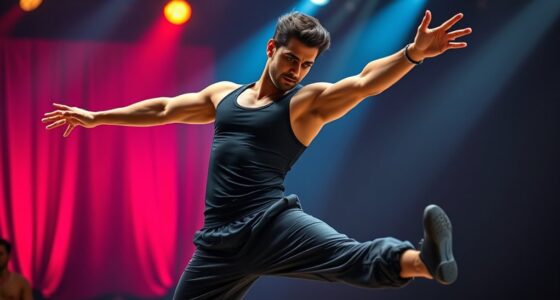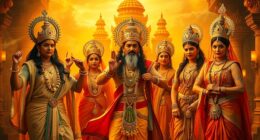The evolution of Bollywood item numbers showcases a vibrant journey from Helen’s captivating cabaret routines in the 1960s to Nora Fatehi’s contemporary hits, blending tradition and modernity. Over the decades, item numbers have reflected changing cultural norms, moving from vamps to mainstream heroines. You’ll see how these performances drive film marketing and spark discussions on societal values, and the continued innovation in this genre promises an exciting future ahead.
Key Takeaways
- Item numbers began in the 1930s, evolving from traditional performances to commercial spectacles featuring popular actresses like Helen and Nora Fatehi.
- The 1940s and 1950s saw cabaret influence, with Helen defining the Indian cabaret style and shaping item numbers’ sensuality and appeal.
- The 1980s introduced disco dance styles, leading to prominent actresses performing item numbers, blurring the lines between heroines and vamps.
- The 2000s marked a surge in mainstream item numbers, transforming marketing strategies and emphasizing catchy sequences to boost film success.
- Contemporary item numbers blend traditional and modern influences, with rising criticism around objectification and a push for more innovative content.
Historical Roots of Item Numbers

Item numbers trace their origins back to the 1930s when performers like Azoorie first captivated audiences with their vibrant dances. Influenced by both traditional Indian dance forms and Western styles, these performances brought a fresh energy to Bollywood.
Early item numbers were often associated with vamps, who showcased risqué routines that pushed societal boundaries. Over time, these numbers evolved from being plot-relevant to standalone attractions, drawing viewers in with their entertainment value. The transition from dedicated dancers to actresses performing item numbers became a norm in Bollywood, highlighting the genre’s evolving landscape.
The term “item number” itself gained popularity in the late 1990s, marking a turning point in how these performances were perceived. Key figures like Cuckoo, Helen, and Silk Smitha paved the way, each adding their unique flair to this evolving art form.
The Rise of Cabaret Influence
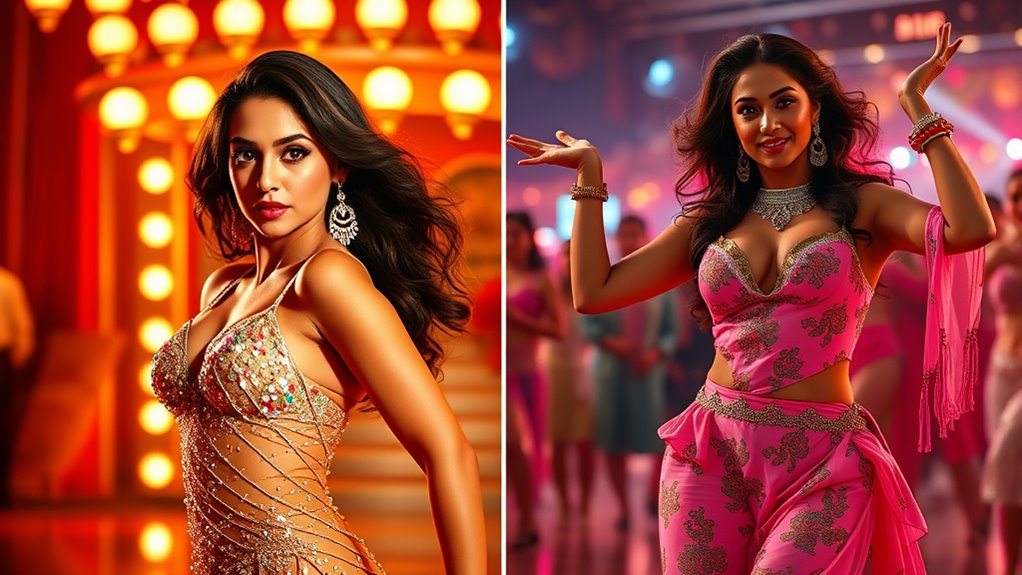
As Bollywood embraced the vibrant energy of cabaret in the 1940s and 1950s, this genre transformed the film landscape, with Cuckoo emerging as a pivotal figure.
The allure of cabaret gained momentum, especially with Helen, who popularized the Indian cabaret style in the 1960s. Bollywood dance represents communal, vibrant revelry, which contributed to the genre’s widespread appeal.
These sensuous dances, typically performed by vamp characters, stood in stark contrast to demure heroines.
This style laid the groundwork for the evolution of item numbers, which became increasingly provocative and commercialized.
Cabaret’s international flair further enhanced its appeal, making it a staple in mainstream cinema.
This influence not only shaped dance choreography but also reflected changing social norms and cultural values, engaging audiences and leaving a lasting mark on Bollywood’s identity.
The 1980s and 1990s: A Shift in Trends

During the 1980s and 1990s, Bollywood experienced a dynamic transformation in its approach to item numbers, reflecting broader cultural shifts and evolving audience tastes.
You’d notice the introduction of Western dance styles, especially disco, in films like *Disco Dancer*. Lead actresses began performing these numbers, blurring lines between vamps and heroines, with notable stars like Silk Smitha and Zeenat Aman. The choreography became more elaborate, enhancing the visual appeal. Item numbers acted as a vehicle for commercial success, encouraging repeat viewings.
The 1990s brought modern item girls, with Madhuri Dixit’s “Choli Ke Peeche Kya Hai” leading the charge. However, this era also saw increased objectification and controversy.
Despite the criticism, item numbers became crucial to a film’s commercial success, often driving audiences back for repeat viewings.
The Mainstreaming of Item Numbers in the 2000s

With the dawn of the 2000s, Bollywood item numbers surged into the mainstream, captivating audiences and transforming the way films were marketed. Top stars began participating in these catchy sequences, boosting film appeal and marketability. For many new actresses, item numbers became a shortcut to success, with figures like Rakhi Sawant rising to fame. The liberalization of India’s economy fostered a consumer culture that embraced these vibrant performances. Item numbers also found their way into pop music and remixes, cementing their cultural significance. They served as effective promotional tools, featured in trailers and post-credit scenes, making them integral to a film’s success. This era marked a significant shift in participation and approach, making item numbers a staple of Bollywood, as they increasingly showcased male actors’ bodies in dance routines to appeal to female spectators.
Contemporary Item Numbers and Their Criticism
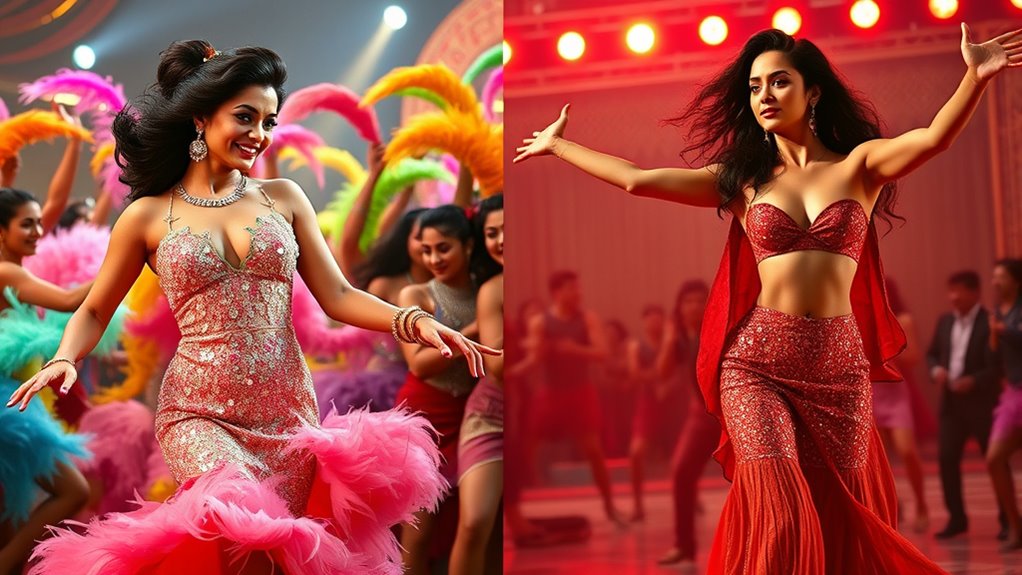
Item numbers have evolved significantly in contemporary Bollywood, blending traditional elements with modern influences. You’ll notice how these performances spread rapidly through digital platforms, increasing their reach and popularity. They now feature a diverse array of performers, from international dancers to stars like Nora Fatehi. While they serve as effective promotional tools, critics argue that item numbers often objectify women, reducing them to mere visual spectacles. This raises important questions about their impact on societal values. However, some filmmakers are experimenting with changing audience sensibilities, offering fresh perspectives. As the debate continues, you can see how these numbers reflect changing audience perceptions, oscillating between empowerment and objectification in the ever-evolving landscape of Bollywood.
The Impact of Item Numbers on Bollywood and Society

While item numbers have become a staple in Bollywood, their impact extends far beyond entertainment, shaping both the film industry and societal attitudes.
These catchy tunes often attract large audiences, driving box office success and launching careers for actresses. However, they also raise concerns about objectification and reinforce stereotypes about women, contributing to a culture that may normalize sexual violence. Critics argue that such songs perpetuate sexism and misogyny in society, further complicating their legacy. In this context, it is important to consider how celebrity relationships can also influence public perception of these portrayals.
You might notice how these depictions influence young people’s perceptions of gender roles and relationships. Despite criticisms, some argue that item numbers can be a form of creative expression and empowerment.
Ultimately, item numbers mirror and shape societal norms, leaving a complex legacy that intertwines Bollywood with broader cultural narratives in India.
Future Directions and Trends in Item Numbers
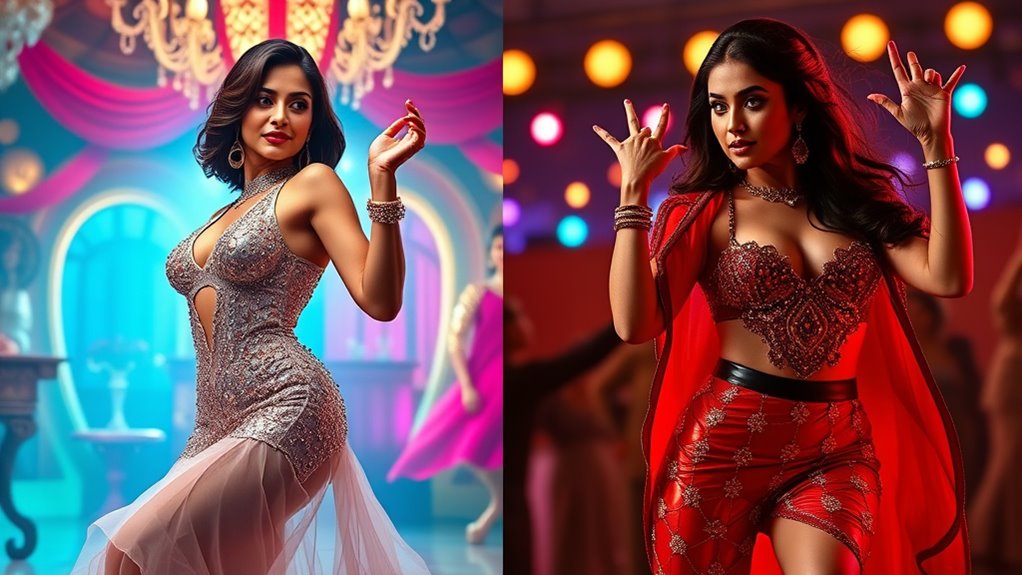
As Bollywood evolves, the future of item numbers looks promising and dynamic, driven by technological advancements and shifting audience preferences.
You’ll notice an increased digital presence, with item numbers racking up billions of views on platforms like YouTube. Item numbers have become a staple for promoting films, attracting attention from moviegoers and enhancing the appeal of films. Top stars are diversifying the landscape, performing these numbers and challenging traditional norms.
Global influences, as seen in hits like “Dilbar,” are reshaping music trends. Expect choreographers to experiment with diverse styles, keeping performances fresh and engaging.
Global influences are transforming music trends, with choreographers embracing diverse styles for fresh and captivating performances.
As audiences become more nuanced, items might tackle deeper themes and social issues, integrating cultural sensitivity.
With advancements in visual effects and potential VR experiences, the future of item numbers promises to be innovative and impactful.
Cultural Significance and Marketing Strategies
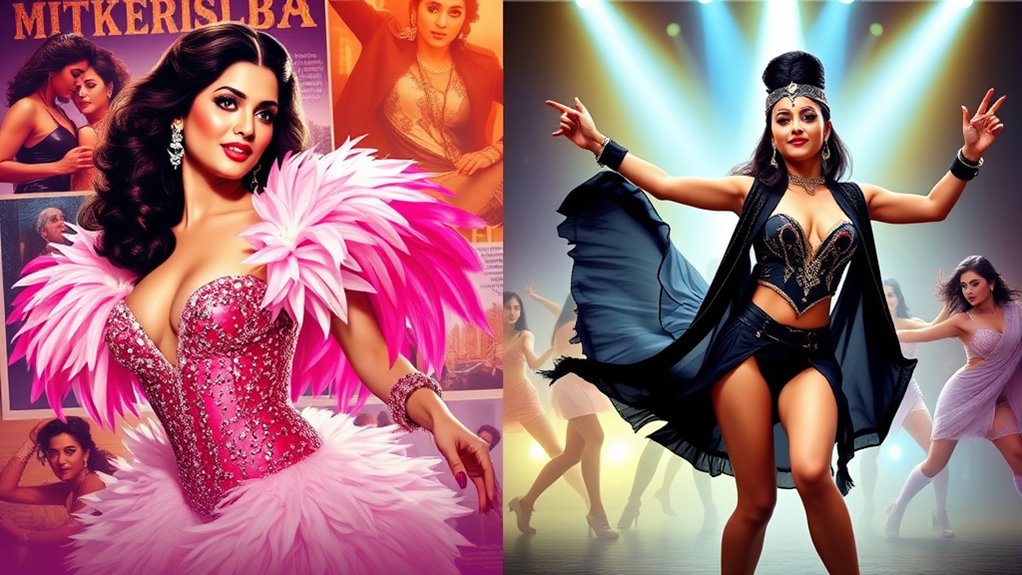
The cultural significance of item numbers in Bollywood goes hand-in-hand with their marketing strategies, creating a powerful synergy that drives both artistic expression and commercial success.
Originating from the 1930s, these numbers reflect evolving societal norms, showcasing themes of love and empowerment. They contribute to India’s cultural identity through diverse dance styles and musical influences, with a strong influence from Western styles that further enriches their appeal.
Marketers leverage item numbers as promotional tools, generating buzz through trailers and teasers. Their visual spectacle, featuring elaborate sets and choreography, captivates audiences, encouraging repeat viewings.
Star power plays a crucial role, as popular actors can elevate a film’s visibility. Ultimately, item numbers not only entertain but also serve as a significant economic driver for Bollywood, influencing global trends in music and dance.
The Democratization of Item Numbers in Modern Cinema
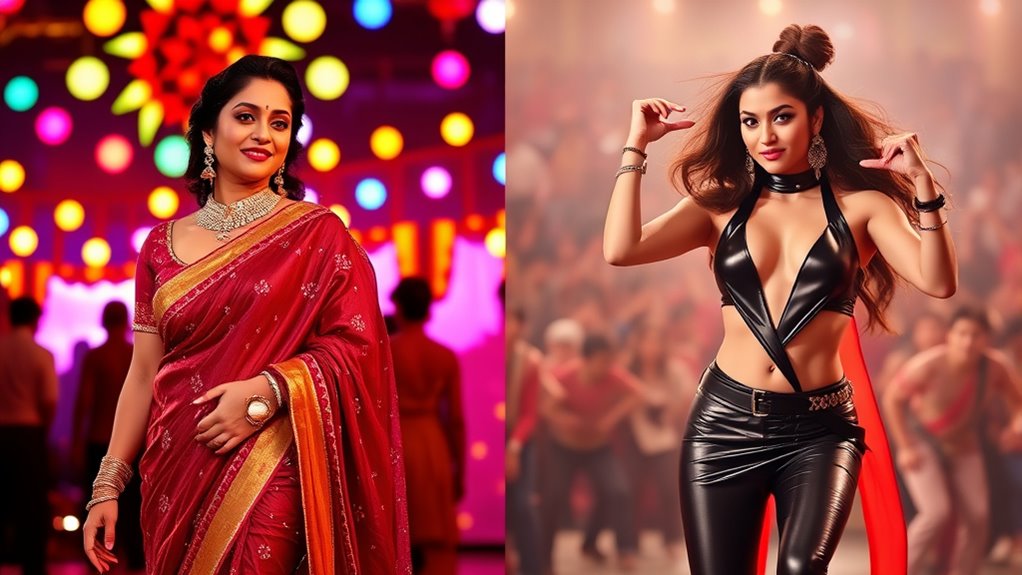
Item numbers in modern cinema have become more inclusive, allowing a wider range of actors, both established and newcomers, to showcase their talents. You’ll notice that both male and female performers, including “item boys,” are gaining recognition alongside traditional “item girls.” The influence of global dance styles and music contributes to a richer cultural exchange, making these performances more dynamic. As the audience tastes evolve, digital platforms have further democratized item numbers, increasing their accessibility and viewership. However, as audiences grow more critical, there’s a push for nuanced portrayals that challenge objectification. While these numbers continue to resonate, they also reflect societal attitudes towards gender and sexuality, urging filmmakers to innovate while remaining culturally sensitive.
Frequently Asked Questions
What Defines an Item Number in Bollywood Films?
An item number in Bollywood films is defined by its catchy music, upbeat tempo, and provocative dance sequences.
You’ll notice that these songs often don’t connect to the plot, yet they grab attention with suggestive choreography and revealing costumes.
Typically performed in vibrant settings like bars or parties, item numbers contribute to a film’s appeal and marketability, making them a staple in Indian cinema, despite ongoing debates about their objectification of women.
Who Are the Most Iconic Item Performers in Bollywood History?
You might think it’s easy to name iconic item performers in Bollywood history, but it’s a colorful tapestry of talent!
From Helen, the original queen dazzling in the ’60s, to Malaika Arora shaking things up in the ’90s, these performers defined the genre.
Don’t forget about Katrina Kaif and Nora Fatehi, who’ve kept the fire burning in recent years. Each brought their flair, making it nearly impossible to forget their unforgettable contributions!
How Do Item Numbers Impact the Film’s Box Office Performance?
Item numbers significantly impact a film’s box office performance by attracting larger audiences with their catchy tunes and vibrant choreography.
You’ll notice that films featuring popular item numbers often generate buzz, leading to increased ticket sales. As these numbers are frequently used in marketing strategies, they create anticipation and engage fans on social media.
Ultimately, a well-executed item number can transform a movie into a cultural phenomenon, boosting its overall revenue and visibility.
Are There Any Awards Specifically for Item Numbers in Bollywood?
Imagine the glitz and glamour of Bollywood, where vibrant dances and catchy tunes steal the show.
Yet, when it comes to awards, you won’t find any dedicated specifically to item numbers. While these numbers often ignite a film’s popularity and marketability, major ceremonies like the Filmfare or IIFA don’t honor them separately.
Instead, they’re celebrated within broader music categories, despite their undeniable impact on a film’s success and cultural resonance.
What Role Does Music Play in Item Numbers’ Popularity?
Music plays a crucial role in item numbers’ popularity by creating catchy melodies that stick in your mind.
You’re drawn in by the upbeat rhythms and vibrant beats, making you want to dance along. Collaborations with talented playback singers boost the appeal, as their versatile voices enhance the overall experience.
Additionally, the fusion of traditional and modern styles adds a unique flavor, ensuring these songs resonate with diverse audiences and keep you coming back for more.
Conclusion
In exploring the evolution of Bollywood item numbers, you see a journey marked by transformation, influence, and creativity. From Helen’s iconic performances to Nora’s electrifying presence, these numbers reflect changing tastes and societal norms. They entertain, provoke, and challenge, shaping both cinema and culture. As you look ahead, you’ll find that item numbers will continue to adapt, inspire, and resonate, proving that in Bollywood, rhythm and allure are always in vogue.
